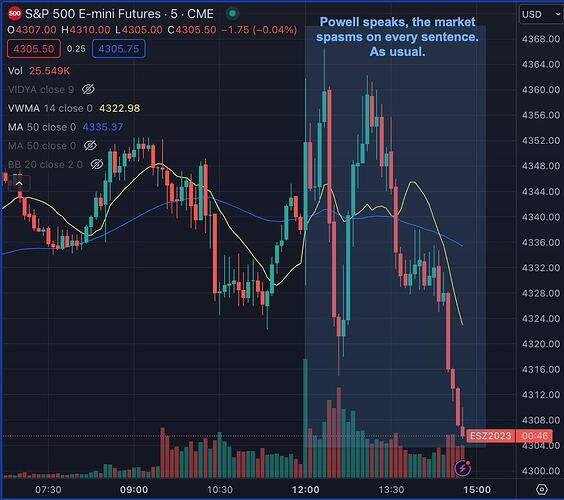Hi @QiQiao, that is a GREAT question, and frankly, one we have been agonizing a bit over in my related non-C2 job.
We’ve had two significant debates in the last month or two. The first was whether or not to scale back our trade quantity and/or target take profit prices for September, knowing that a) September is an historically bad month for the market, and b) our strategies are inherently long-biased (because of the general market direction of the majority of data our models are trained/tuned on).
The second point of discussion is what to do around Fed announcements. As I’ve mentioned above, the vast majority of the time, at least in the last two years, the market reaction to just about ANY Fed meeting/statement is the same: jump off a cliff, and then recover over the following week. That is obviously not guaranteed, but is VERY probable given past performance.
So, knowing both pieces of data above, what (if anything) did we do differently for September? With great hindsight regret, the answer is nothing. Yet.
We decided not to scale back our trading for September simply because our strategies, while long-biased, have navigated red market months quite well since going live (non-C2) in May of 2022. Including last September, which was a BLOODY month for the S&P, yet we returned positive ROI.
This month obviously could not have been more different. We were held hostage by a long position we entered on 9/5 and basically held (as the market went sideways in a relatively tight range peaking just below our take profit target) until it stopped out post-Fed meeting on 9/21, hitting our fail safe “everything has gone wrong” catastrophic MaxDD stop loss, which we’ve only hit I think twice before in the last year.
Regarding the Fed meeting market behavior, we actually do already have logic in place that does not allow our system to open a new position within X hours of either the Fed minutes release or the Fed meeting/rate announcement. However, what we do not have logic for (yet) is what to do if we’re already holding an open position going into one of those events. Looking at our 15-16 month history of running these strategies, the majority of the time during these Fed events either a) our strategies are already in cash, so it’s a non-issue, b) the initial market knee-jerk is in the direction of our open position, closing it in profit, or c) given the volatility leading up to these Fed events, our dynamic stop loss is adjusted wide enough to allow for the initial knee-jerk market move without stopping out.
This month, however, was obviously none of those outcomes. We were already so close to our static “catastrophic” stop loss value for our 2+ week open long that the post-Fed market movement subsequently triggered it, stopping out for a huge loss. Our dynamic stop loss might have been able to ride out the post-Fed drawdown if we hadn’t already been so close to stopping out with our static “worst case scenario” stop loss, but that’s a moot point.
So, what are our lessons learned going forward? First, we have decided that specifically for September (and possibly for August and October), we are going to reduce our trade quantity (not really applicable here on C2) and tighten our take profit targets for long positions. While we’ve faired well in previous red months, we got our butt kicked for this one. And we know September historically is a tough market month.
For the Fed events, we’re testing ideas now on what to do when we have a position open going into it. Do we just dump any open positions X hours before the event? Do we only dump longs? Do we dump 50% of an open long pre-Fed, and then buy it back if the market drops X points? And 20 other possibilities we are brainstorming and will be testing.
All that to say, hindsight is 20/20, but knowing what we know about the probable outcomes of both a) September market performance, and b) market behavior around Fed events, we are VERY aware that we need to make some adjustments, and that us doing well overall over the last 16 months or so around these events may have been more about good luck and timing than it was specific processes around these events.
We certainly don’t want to overreact (or over tune) for this horrible month, but this month has shown us we do need more logic/processes in place around these events.















